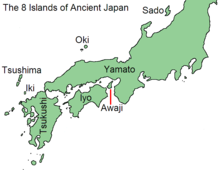|
Kuniumi
In Japanese mythology, Kuniumi (国産み, literally "birth or formation of the country") is the traditional and legendary history of the emergence of the Japanese archipelago, of islands, as narrated in the Kojiki and Nihon Shoki. According to this legend, after the creation of Heaven and Earth, the gods Izanagi and Izanami were given the task of forming a series of islands that would become what is now Japan. In Japanese mythology, these islands make up the known world. The creation of Japan is followed by the creation of the gods (kamiumi). Creation story According to the KojikiAfter the formation, Heaven was above and Earth was still a drifting soft mush. The first five gods named Kotoamatsukami (別天津神, "Separate Heavenly Deities") were lone deities without sex[1] and did not reproduce. Then came the Kamiyonanayo (神世七代, "The Seven Divine Generations"), consisting of two lone deities followed by five couples. The elder gods delegated the youngest couple Izanagi and Izanami to carry out their venerable mandate: to reach down from heaven and give solid form to the earth. This they did with the use of a precious stone-covered spear named Ame-no-nuboko (天沼矛, "heavenly jewelled spear"), given to them by the elders. Standing over the Ame-no-ukihashi (天浮橋, "floating bridge of heaven"), they churned the chaotic mass with the spear. When drops of salty water fell from the tip, they formed into the first island, Onogoroshima. In forming this island, both gods came down from heaven, and spontaneously built a central support column [2] called the Ame-no-mihashira (天御柱, "heavenly pillar") which upheld the "hall measuring eight fathoms" that the gods caused to appear afterwards.[1][3][4][5] Then they initiated conversation inquiring of each other's anatomy, leading to a mutual decision to mate and reproduce:[4]
Izanami accepted the offer and Izanagi proposed that both should circle around the column Ame-no-mihashira in opposite directions, Izanami going right and Izanagi left and on meeting each other would perform sexual intercourse (maguwai (麻具波比)). However, when they met on the other side of the pillar, Izanami was the first to speak, saying: "Oh, indeed you are a beautiful and kind youth!", to which Izanagi replied: "Oh, what a most beautiful and kind youth!". Izanagi then rebukes Izanami saying: "It is wrong for the wife to speak first.".[4] However, they mated anyway and later fathered a child Hiruko (lit. "leech child), who was placed in a reed boat dragged by the current.[nb 4] Afterwards they gave birth to Awashima (淡島, lit. "island of foam"). Neither Hiruko nor Awashima were considered legitimate children of Izanagi and Izanami.[4] Izanagi and Izanami decided to ascend to heaven and consult the primordial gods at Takamagahara about the ill-formed children that resulted from their union. The gods determined through divination that the female speaking first during the ceremony was the cause. So the couple returned to Onogoroshima island and repeated the rite encircling the column, only making sure Izanagi was the first to speak out in greeting. When finished, they performed the union successfully and lands began to be born.[6] Birth of the islandsAccording to the legend, the formation of Japan began with the creation of eight large islands by Izanagi and Izanami. In order of birth these islands are the following:[6] 
Traditionally these islands are known as Ōyashima (lit. eight large islands) and as a whole are what is currently known as Japan. In the myth neither Hokkaidō nor the Ryukyu Islands are mentioned as these were not known to the Japanese at the time of compiling the Kojiki.[6] Additionally, Izanagi and Izanami then gave birth to six islands:[6][7]
According to the Nihon ShokiThe story of this book only differs in that Izanagi and Izanami volunteered to consolidate the earth. In addition, the two deities are described as "god of yang" (陽神 youshin, male deity) and "goddess of yin" (陰神 inshin, female deity) influenced by the ideas of Yin and yang. The rest of the story is identical, except that the other celestial gods (Kotoamatsukami) do not appear, nor are the last six smaller islands mentioned that were born through Izanagi and Izanami. Notes
References
Bibliography
|

